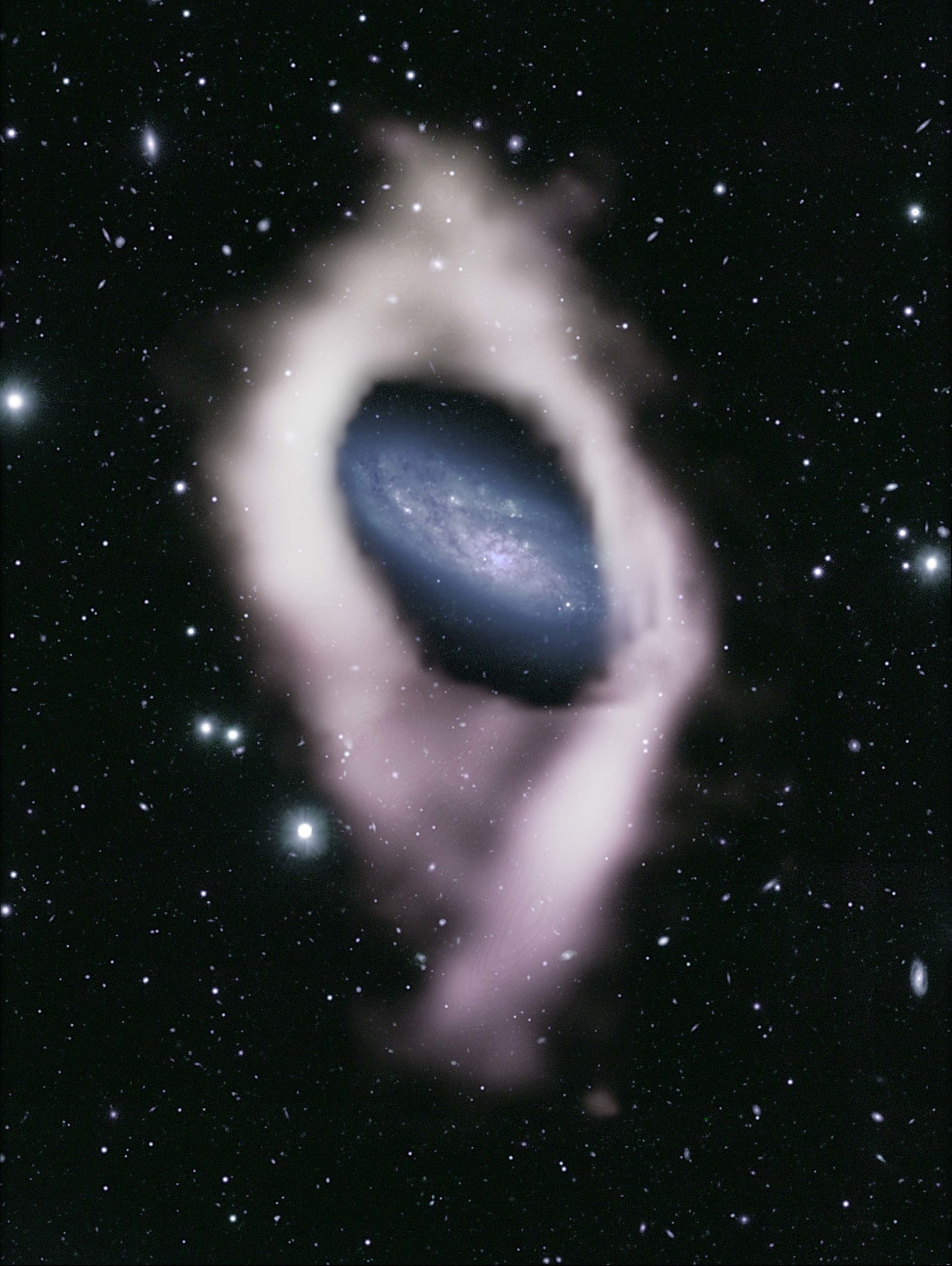
The galaxy NGC 4632 surrounded by a ring of cold hydrogen gas. Using the ASKAP telescope, scientists discovered that this galaxy contains a (potential) polar ring of gas that orbits the galaxy at ~90 degrees relative to its body. The separation of the gas from the main body was made possible through the use of VR analysis enabled by the iDaVIE-v software developed at the IDIA Visualisation Lab.
Image Credit: Jayanne English (U. Manitoba), Nathan Deg (Queen’s U.) & WALLABY Survey, CSIRO/ASKAP, NAOJ/Subaru Telescope
Science Credit: N. Deg and K. Spekkens (Queen’s U.) and WALLABY survey (CSIRO/ASKAP).
13 September 2023
A team of international astronomers, including those from the University of Cape Town (UCT) and Queen’s University, have revealed a galaxy wrapped in a cosmic ‘ribbon’ using a telescope owned and operated by CSIRO, Australia’s national science agency.
Published today in Monthly Notices of the Royal Astronomical Society, the research presents a stunning image of a galaxy called NGC 4632 that is 56 million light years from Earth. It has been identified as a potential polar ring galaxy, which are some of the most spectacular types of galaxies in the universe, and among the most mysterious.
Detected using CSIRO’s ASKAP radio telescope on Wajarri Yamaji Country in Western Australia, the galaxy features a ring of gas that can only be seen at radio wavelengths. The ring is orbiting the galaxy at right angles to its spiral disk, like a parcel wrapped in a ribbon of cosmic gas, dust and stars.
Professor Thomas Jarrett, director of the IDIA Visualisation Lab based in the Department of Astronomy at UCT, said: “In the future, polar ring galaxies can also be used to deepen our understanding of the universe, with potential applications in dark matter research. It is possible to use polar rings to probe the shape of dark matter of the host galaxy, which could lead to new clues about the mysterious properties of the elusive substance.”
Dr Lucia Marchetti, senior lecturer in the Department of Astronomy at UCT and project scientist of the IDIAVisualisation Lab, added: “We are very pleased to see that our in-house developed VR software – iDaVIE-v – is yet again used by the international community to enable scientific discoveries like this one. The VR immersive environment created by our tool provides a unique view of the data that allows the user to see 3D structures otherwise almost impossible to spot and study in 2D. We expect to see more and more results like this in the future as more and more users will start using our software for astronomical and interdisciplinary studies.”
Why polar rings exist is still a puzzle to astronomers. One possible explanation is that their stellar rings, which appear blended with gas clouds, are shredded material from a passing galaxy. Another possibility is that hydrogen gas flows along the filaments of the cosmic web and accretes into a ring around a galaxy, possibly forming stars during this process.
Dr Nathan Deg, researcher in the Department of Physics, Engineering Physics and Astronomy at Queen’s University and co-author on the study, said: “The findings suggest that one to three per cent of nearby galaxies may have gaseous polar rings, which is much higher than suggested by optical telescopes. Polar ring galaxies might be more common than previously thought. While this is not the first time astronomers have observed polar ring galaxies, NGC 4632 is the first observed with ASKAP and there may be many more to come.”
Over 25 global collaborators from Canada, Australia, South Africa, Ecuador, Burkina Faso, Germany, China, and beyond worked together to analyse data from the first WALLABY (the Widefield ASKAP L-Band Legacy All-Sky Blind Survey) survey collected using ASKAP and processed by the Pawsey Supercomputing Research Centre in Western Australia. Notably, ASKAP is one of the precursor for the SKA-mid array, as is MeerKAT in South Africa.
Professor Bärbel Koribalski from CSIRO said the WALLABY survey aims to observe the whole southern sky using ASKAP to detect and visualise the gas distribution in hundreds of thousands of galaxies.
“NGC 4632 is one of two polar ring galaxies we’ve identified from 600 galaxies that were mapped in our first small WALLABY survey. Using ASKAP over coming years we expect to reveal more than 200,000 hydrogen-rich galaxies, among them many more unusual galaxies like these ones with polar rings,” Koribalski said.
Here is also a video that comes with the release, here is the link to it: https://youtu.be/dkMr-D2719w
ENDS
